
Combining photographs and using different media with photographs has been part of photography ever since its beginnings in the mid-1800s. (1) There are a number of words to describe these works. Most often the words used, many times interchangeably, are: collage, montage and bricolage. Torrie Groening (2), a Vancouver-based Canadian artist, is a master printer who embraces the use of photography with other media. Her work is a combination of drawing, painting, printmaking and photography, with a keen eye towards the use and organization of color.
Groening describes her work using the term photomontage. “The term ‘photomontage’ was not invented until just after the First World War, when the Berlin Dadaists needed a name to describe their new technique of introducing photographs into their work. .. This term …means to construct, to assemble… Montage in German means ‘fitting’ or ‘assembly line’, and Monteur ‘mechanic’, ‘engineer’”. (3) Much earlier, artists began cutting and pasting images. This activity was termed collage: “the term collages, the noun from the French “Coller”, literally ‘to glue’ or ‘to stick’.” (4) A photo collage is often thought of as a number of different photographs cut and literally pasted together. Pablo Picasso and Georges Braque were some of the earliest collagists, and may well have defined this as an art form.
Later artists, like Max Ernst, made use of photographs in collages. Using photography in collages and montage work gave artists the ability to combine reality with imagination. There are a number of familiar names of artists who sprouted up using photo collage and photomontage: El Lissitzsky, Christian Schaad, Herbert Bayer, Frederich Sommer, Jerry Uelsmann, Laszlo Maholy-Nagy, Man Ray, and Maurice Tabard. Two dimensional works then evolved into three dimensional objects. “Bricolage” is a French term for constructing a work from a diverse range of available things. A bricolage mixed-media work is more three dimensional with the assemblage of physical objects rather than limited to works on paper.
For some, the photomontage is a challenge to our perception of “what is” a photograph. Some think of a photograph as a physical exact reproduction of what we see. It is an image composed in the camera. The physical print was viewed as the art object captured by using the camera. Today, the object of art is varied and can exist in an ephemeral “cloud”, or other recording device, as an aggregation of pixels, as a digital record, or in some other physical form. Groening’s work is physical and generally a large printed image. She described her process: “Objects are first staged and photographed in a still life setting that often include my own artworks. The resulting digital file becomes the start of a many layered image approached by the artist much like a painter – adding, removing and using images and tools as required by the image”. She uses digital and physical drawings and creates a still life of these images that are then photographed. “Reacting to the impact of the computer and the Internet, photography is in the midst of a historic shift in which the photographic image is no longer synonymous with camerawork”. (5) Groening’s works are, therefore, photography-based mixed media art objects referred to as photomontage.
Groening, in the current age of technology, uses the art capabilities of digital media to create a photomontage. How images are combined can take many forms. Early on, photographers collaged the negatives of an image to create a photograph that appeared seamlessly real. For example, Oscar G. Rejlander’s “The Two Ways of Life (1857)”. Gustave Le Gray famously combined one exposure of the sky with a different exposure for the land. Combined together, a more realistic image was created that overcame the technical difficulties of photography to make an evenly exposed single image where the darkness of land and brightness of sky could not be captured at the same time. These early works are fundamentally different from later images that became photo collage or photomontage.
Later images were not meant to capture a realistic image of what was in front of the camera lens. One of these methods involved not altering any one negative, but combining two or more negative into one image. One of the most known practitioners of this method was Jerry Uelsmann. Uelsman combined images in a traditional “wet” darkroom to create a fanciful image that did not pretend to reflect a specific factual reality, but was an image that emerged out of his own imagination and creativity. He did not incorporate other media, such as etchings, painting or drawings. This is where Torrie Groening’s work is different.
As an artist who paints and draws in media other than photography, Groening develops a unique approach to the photomontage. Photo collage and later, photomontage, was used to communicate a visual message, especially during the Dadaist movement that developed around and after World War 1. Collage and montage became a technique to illustrate one’s political views and/or exercise one’s imagination. The early Dadaist movement cut up and pasted together images taken from magazines and other sources, and were not necessarily created by the artist. In contrast, all elements of Groening’s work are her own creation. Where early photographers might have combined film negatives and magazine cut outs, Groening uses digital files. Where in the past a montage was “photo mechanical”, today it may be, in whole or in part, a digital construction.
Groening is not a documentary photographer. Her images are not manipulating something that might otherwise be documentary. Persons are not inserted or removed to change what was, had been or is part of a moment in time and place under the guise of accuracy and/or truthfulness. “Contrary to Moholy-Nagy and Blossfeldt’s whole-hearted embrace of photography’s truth-telling capacity, practitioners of photomontage set out to both champion and undercut the medium’s claims of veracity”. (6) In “A Sudden Flutter” we see Groening’s vivid imagination at work.
 “A Sudden Flutter (2009), from the series “Grand Scenarios”, by Torrie Groening © Image used with permission of the artist.
“A Sudden Flutter (2009), from the series “Grand Scenarios”, by Torrie Groening © Image used with permission of the artist.
“A Sudden Flutter” is the beginning of her photographic artworks. It is from her first series, “Grand Scenarios”. Groening refers to this image as “a little metaphysical… I imagine the artist drawing nature, trying to ‘capture’ the lilies before they quickly wilt. The scene is so colorful in comparison to the black and white drawings and etchings she is creating. Animals and bugs are attracted to the lush scene and overwhelm this artist’s attempt to draw… Whoosh, all the art is blown up and the artist vanishes with her eyeballs still on the drawing board. … I was aware of the huge changes possible to me with new technology and tools. Living in San Francisco during the time when artists, galleries and museums were just starting to embrace a hybrid artistic practice that included not only digital photography, but traditional studio work, there was the seemingly unstoppable influence of Adobe Photoshop. I was able to study with some of Adobe’s top creative forces and see first hand how contemporary artists there such as Deborah Orapallo, Enrique Chagoya and William Wiley were using digital photography and technology. These were artists well established and experienced in traditional printmaking that were individually using new technology as it suited their intentions”.
We see objects, themes and technique that will recur throughout her work. In “A Sudden Flutter”, we observe an office setting: a chair and a desk. There must have been an open window nearby, as we see on the right a column of loose papers rising up in a “flutter” into the air from the desk. Looking carefully we also see that each page is a work of art drawn by Groening. Each one has a well drawn sketch on it or a flower, and two that look like test prints that give hints of future photographs to come. On the left side of the image, we see 12 or more butterflies entering the image and vases full of brightly covered flowers. The butterflies are from her own collection and are real. We also see vases drawn on a print on the back wall. Each of the butterflies and a bird is a beautiful and precisely drawn image and extremely life-like. Groening let’s us know that “The title, A Sudden Flutter is a reference to Hokasai’s woodcut, A Sudden Gust of Wind, which was also the framework of (Canadian) Jeff Wall’s photomontage with the same title. So, the ‘flutter’ here is the technology and rapid change in approaching art for the artists and viewer”.
Another recurring theme in her works is evidence of color, literally. She often inserts a spectrum of color from yellow to violet somewhere in her images. We see on the left, pinned to the wall, a color chart that looks painted by an artist testing a mix of colors. On the desk are tools of her trade. There are pencils and chalk. The image is very bright, positive and cheerful. Between the flight of butterflies and the rising coil of papers, an energy emerges from this two dimensional image that affects the viewer in a very positive way. As one is drawn into the image, a viewer with a soured disposition can not resist the urge to feel light and buoyant.
Groening’s work is not a haphazard construction. She is very purposeful and “intentionally theatrical”. Following the historical development of collage and montage, there was a period following the Dadaist movement and later attached to the Surrealist period that was referred to as “Automatism”. “Automatism” was an art movement where the surrealists emphasized abstracting the familiar and changing what we think we saw. Groening is the exact opposite. Her images are carefully orchestrated. The recurring themes in her work are evidence of a consistency of thought, plan and reflection. Each image, etching or drawing is carefully placed. She wants the viewer to create and understand the scene and each object in the composition.
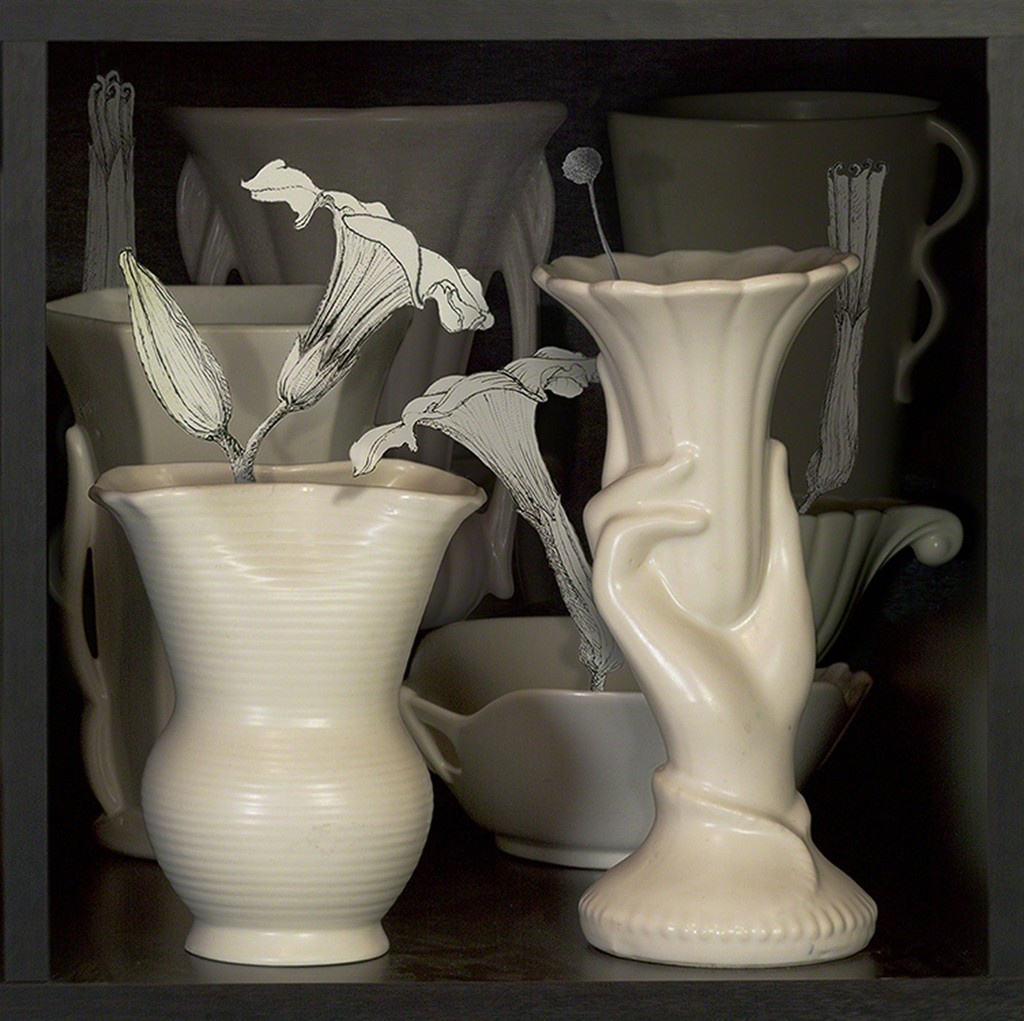 “Trumpet Holder (2016)”, from the “Shelf Collector” series, by Torrie Groening © Image used with the permission the artist.
“Trumpet Holder (2016)”, from the “Shelf Collector” series, by Torrie Groening © Image used with the permission the artist.
The series “Shelf Collector” “[i]n keeping with an overarching theme of still life … engages a personal collection of porcelain vessels and antique portrait frames with the artist’s drawings, prints and photographs.” (7) She creates images as scenes within a defined space as in “Trumpet Holder (2016)”. Groening is drawn to vases: “I was particularly attracted to the symmetrical handles of the vessels which appear anthropomorphic in their figurative and feminine shape”. In this print, the viewer focuses attention on the flowers sketched in black and white, and the very gentle shapes of the urns. The image has a somber feel. There is an inviting but formal tone to the image. It is low in contrast. The image is not a stark high contrast image, but one with a great tonal range where the two vases are set out in detail with lighting that allows the rounded shape of the urns to be gently appreciated. In the background, we see other vases and a bowl, but almost faded and receding into a dark shadowed background. This clever use of light gives a defined foreground and background to the image. While older collages and montages were very two-dimensional flat images, Groening’s image has depth and dimension. Even though the image is printed on a two dimensional plane of paper, the image has a three dimensional look and feel. Like an early Italian Renaissance painting, she carefully draws the viewer’s eye through and deep into the image. Even with her definition of space, there is a carefully balanced scale of size and physical relationship. Objects relate to each other in proper proportion. The objects are not enlarged or shrunken for emphasis. However, rarely is the viewer given an elevated or angled perspective. Most of the images are straight on visual approaches.
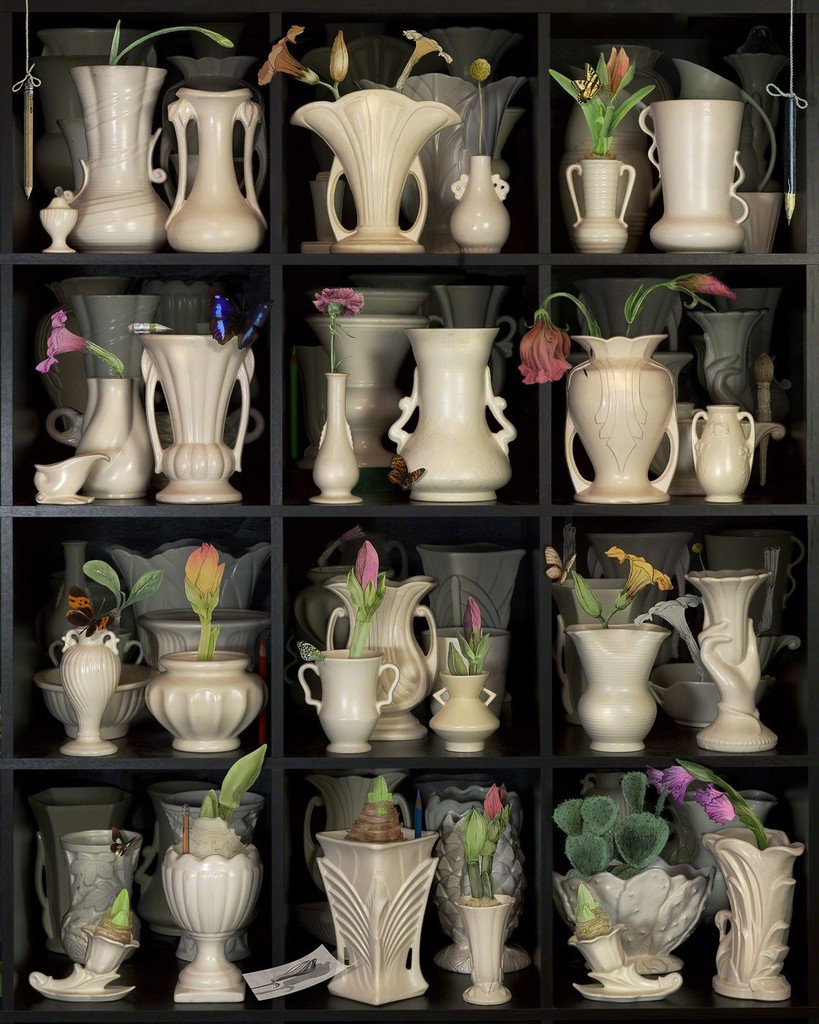
In the image “Destiny Bouquet”, there is a shelf with three columns across and four rows. Each row is filled with off-white urns or vases. Several contain images of cut flowers that have been drawn by Groening and collaged into the image. The shelves have a very orderly appearance. Each urn and flower look very intentionally and carefully placed. The eye is drawn into each cubby. It is a visual challenge for the viewer, but in a good way. First, the drawings of the flowers are in color. This adds a life and dimension to the image. An uncommitted casual passing glance does not work with Groening’s art; it grabs and engages the viewer. This is especially true with an image like “Destiny Bouquet” which contains 12 different Trumpet Holder-like images combined into one. This is another Groening technique. She will create one stand alone image; but then recreate it in different arrangements. These different arrangements then find their way into one image that is a visual compilation of many of the works.
From “Grand Scenarios” and the “Shelf Collector” series, we see another characteristic of Groening’s montages. Unlike the collage/montage art of the early Dadaist movement, Groening does not incorporate text or words. The viewer should be conscious and aware of this. This is in stark contrast to the 1920’s works of Hannah Höch, John Heartfelt, Helmut Herzfelde and others. In those earlier collages, words are presented as a hint of the message or directed underlying meaning embedded by the artist. A collage/montage without words gives a freedom of interpretation to the viewer. Those early works were very political in tone. Groening’s work is not political. It is not a social commentary. If her work is not political or social, what then is it? Her work is an expression of her inner self. The challenge is really looking at the objects she selects and thinking about why these were selected and placed into the composition.
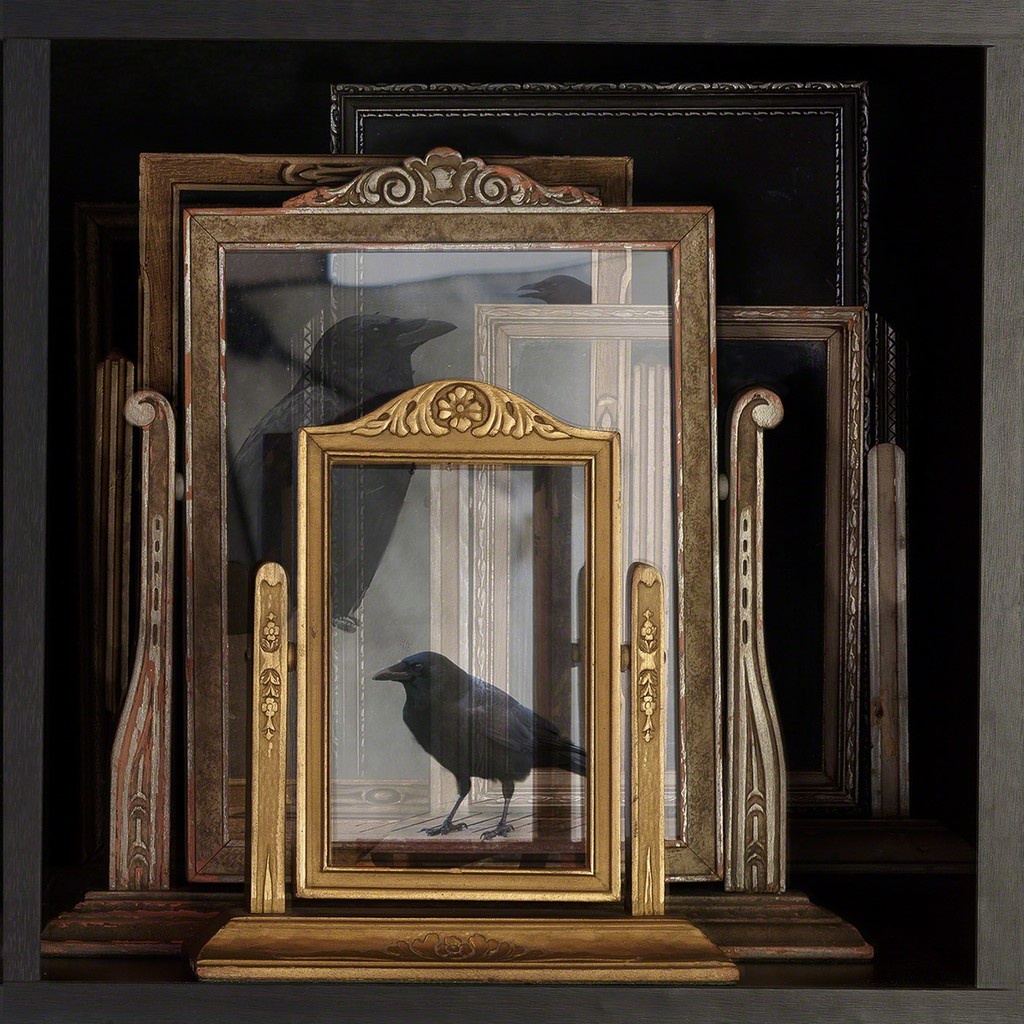 “Frame Collector with Crow 2 (2017) from the series “Shelf Collector”. Image by Torrie Groening © Image used with the permission of the artist.
“Frame Collector with Crow 2 (2017) from the series “Shelf Collector”. Image by Torrie Groening © Image used with the permission of the artist.
She will frequently compose her images in a way that allows some objects, such as a frame or a window that act as a portal to view another scene, as in “Spring Predictor”, or, as an entry to the space or introduction to the viewer like the crow within the frames in “Frame Collector Crow2”. The bird she uses in these images is what she calls a “Vancouver Crow”, a smart and crafty feathered creature around which she created the “Frame Collector Crow2” image and the following “East West Connector” image. Similar to “Trumpet Holder” and “Destiny Bouquet”, the “Frame Collector Crow2” is a single frame image that matches with “East West Connector” as a visual of 12 separate images combined into one large image.

The use of frames in the “crow images”, unlike the use of vases/urns in the other images in the “Shelf Collector” series, can drive a certain intense focus in the viewer. We are used to seeing a specific image placed in a single frame. It is a way to direct our eye’s focus. An object is framed, and we are cued to look at it and study it. These images, however, contain several empty frames. The frames themselves are all different styles. One can study and compare frames, but within some of the frames are images of the Vancouver Crow. We have to ask ourselves, why the crow? In her other earlier images we see birds, but not crows. The birds in her other images are brightly colored delicate song birds. These black crows have a reputation for mischief, calculation and thievery. Other birds do not steal from people the way crows have the reputation of doing. Other birds are all around us, but do not interact as directly with people as crows do. Groening described the crows: “The crows match your gaze and are ‘lookers and noticers’ of detail. Often you will not notice you are being observed but the feeling is there”. She chose the Vancouver Crow because Groening herself is from Vancouver. “Vancouver is a city of crows. … Central to the appeal of crows is their intelligence. … studies of facial recognition in crows show that evolutionarily, crows have learned to focus both on people who feed them and those who threaten them. … a recent UK study showed that crows are the ultimate problem solvers.’ ” (8) So the crow should not create an apprehension in the viewer; but, perhaps it does? Looking at “Frame Collector Crow2”, the viewer is confronted with an image of an image within an image with multiple frames, where instinctively we are looking for other images. The crow seems to have wandered into the frames as the photograph was being taken. In others, there appears to be a reflection of a crow in glass. Once again, Groening finds a way to capture and hold our attention.
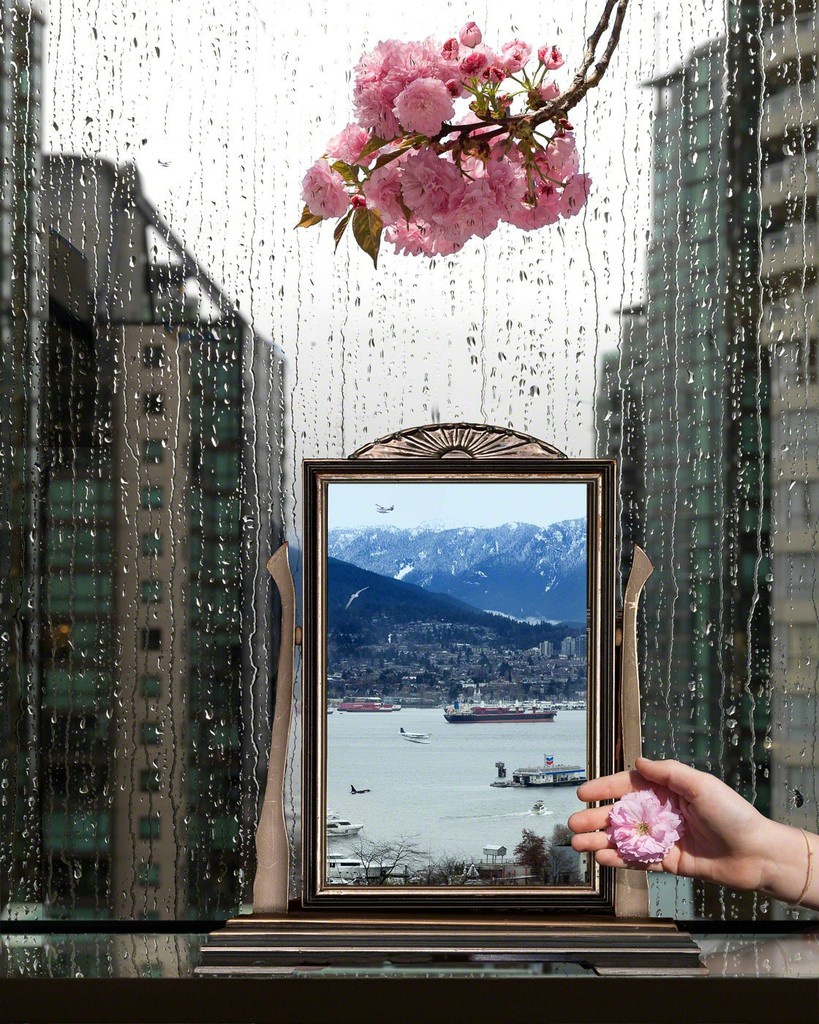
Following the “Shelf Collector Series” is the “Out of Studio”portfolio. “Out of Studio is an ongoing series that depicts the makeshift studio of a traveling artist. The still life compositions reference real and constructed locations. Employing [the] artist’s personal materials, brushes, paints and surfaces as props each work invites the viewer to experience the setting as the artist might; the moment just before putting paint to paper, …”. (9) The “Out of Studio” work are photomontages, but it is difficult to know that unless one looks carefully at each image. As with her prior work, she speaks to time and space. In “Spring Predictor (Vancouver)”, rain, typical of spring, is all over the window of a room high up in a building. The rain outside reminds us of changing seasons. Yet, just inside the window, a branch, full of pink flowers appears. A flower, held by a bodiless hand, appears from the right side of the image. Groening explained further: “The rain on the ‘wet coast’ in the Spring makes us love the Cherry Blossoms that are planted all over the city and are celebrated in a festival of pink”. A frame sits on the window sill, apparently empty and at the same time giving the viewer the image of a bay of water, ships, planes and mountains with clear skies and no rain. The contradiction in the weather is the artist playing games with the observer. We know that outside it is raining. Yet, Groening is giving the viewer a clear look beyond, into a current or future state in another place, and perhaps a different time. When looking closer at the image within the frame, one is surprised to see two planes and a small private jet crossing the sky. On the one hand, perhaps that is a lucky coincidence? On the other, it may be intentional on the part of the artist to give a hint to the viewer that the artist has traveled to this place. In each image in this series, there is something out of place beyond our expectations.
In “Color Collectors”, Groening most current body of work, all the objects, unlike her prior works, float freely in space, weightless and gravity free. Groening changes our view of space and dimension. In her previous images, all objects were in context and a defined space. The objects bore the weight of gravity. In “Color Collectors” there are no horizon lines, rooms, boxes or frames to give us perspective. She denies us these traditional reference points.
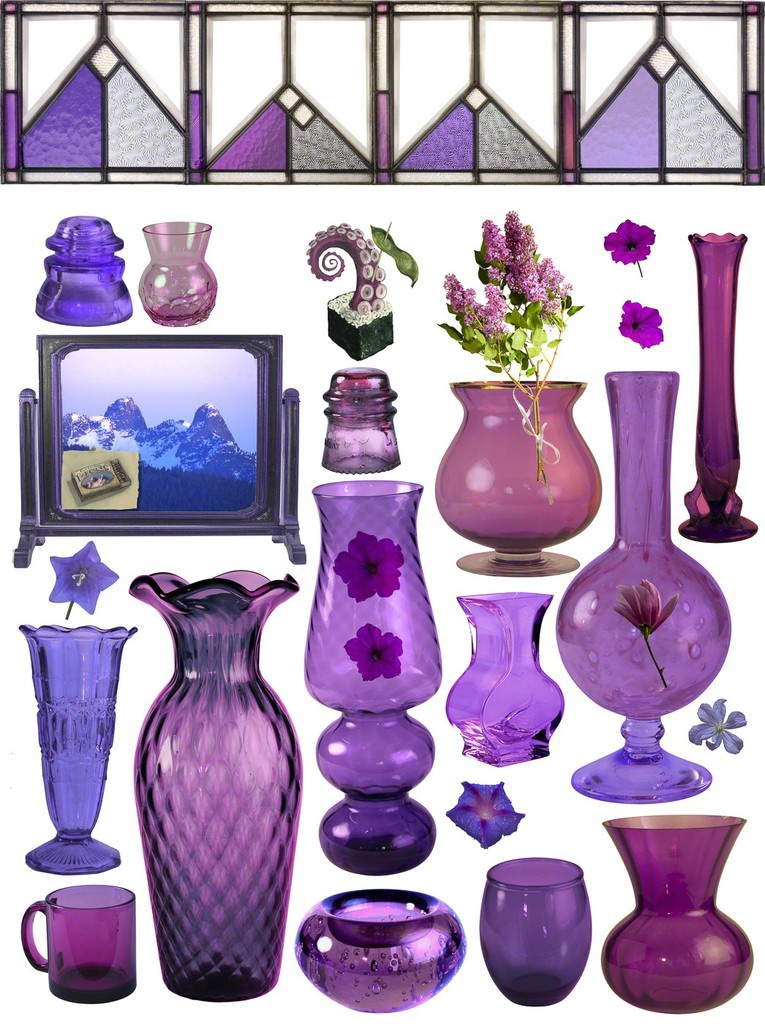
The quality of each separate image is amazingly crisp. The color is full of a light that seems to emanate through each piece of glass. The series can be mounted on and seen through a substrate like glass to let light flow through and radiates the photographed objects. All the objects are different sizes and shapes of glass, but, on any one image, all the same color. As with her prior series, the objects come, for the most part, from her own collection of “jeweled-toned glass objects and augmented by flea market finds”. When printed on paper, it is two dimensional, yet on glass it is in a place beyond two dimensional, albeit not 3D.
The viewer is visually entertained by a variety of styles and types of glass. In addition to the vividness of the colors, we take delight in looking at each object in the image. Each piece of glass stands alone in asking for the viewer’s attention to its detail and purpose. The image itself, in each panel, while lacking a horizon line or room, is anchored by a Tiffany style row of glass across the top. While the image appears to have no lines defining its sides or bottom, the glass at the top creates a top of image that invisibly creates a sense-of-a-frame around the glass collection. Our mind treats what we see as a “framed” image, even though all the objects are anchor-less and freely floating untethered in space.
While seemingly different than what she has done before, we find consistent threads throughout her work. Each of the panels in the series is a different color, consistent with her focus on the color spectrum. We see in the image a plant and some flowers, as we find in many of her images. There is a picture frame which reminds us of her other works. This picture frame, as in other images, passes the viewer into a different location; in this case, a distant snow-capped mountain. In that same frame is a small match-book box type object that, upon close examination, also has a mountain scene that look like the scene it rests upon. All of these together reminds us of this artist’s very close attention to details and organization.
Torrie Groening’s training and recognition as a master printer is evident throughout all of her work. She has used photography, not to document what is before the lens, but as a tool to create. Following a long tradition of photo collage and photomontage, she has used her imagination to embed a story into her visual images. Without using words in her images, the viewer gets visual hints. The images draw us in and force us to think about what we are seeing much like what was said about Moholy-Nagy. “Photography for Moholy-Nagy was of inestimable value in educating the eye to what he called the ‘new vision’. He believed that inner efforts to come to terms with the age of technology, to become part of it and not to sink back into retrogressive symbolism and expressionism, the camera with it’s capacity to complete or supplement our optical instrument ‘the eye’ would help us disengage ourselves from transitional perceptual habits”. (10) Photomontage, used well, helps us see differently. “Taking and remaking, juxtaposing and superimposing, scribbling over and painting on, flattening or inflating space, dreaming and haranguing-the strategies of collage are almost endless because collage is the medium that embraces almost everything”. (11) While the terms for collage and montage seem to have different origins, the words are frequently used interchangeably. Whether you refer to her work as photo collage or photo montage, the discussion is the same. With Groening’s work, the use of photomontage is her visual communication that invites appreciation of the approach and engagement, to interpret what cues are in each image, and to help us see differently.
Notes:
- See Mia Fineman’s excellent book, “Faking it: Manipulated Photography before Photoshop” (2012), The Metropolitan Museum of Art (New York) on this topic.
- http://www.torriegroening.com/about/
- “Photomontage’, Dawn Ades, Thames and Hudson, Ltd (London), 1976.
- “Collage: The Making of Modern Art”, Brandon Taylor, Thames and Hudson, Ltd (London), 2004.
- “Collage and the Photographic Imagination”, Barbara Confino, July 6, 2016, International Center for Photography.
- Op cit., Brandon Taylor, “Collage: The Making of Modern Art”., p. 72.
- http://www.torriegroening.com/new-works-in-the-studio/
- “ ‘They’re just crows:’ Researcher says the birds don’t deserve their bad rep”, Vancouver News, November 16, 2017. http://www.metronews.ca/news/vancouver/2017/11/16/vancouver-city-of-crows.html
- http://www.torriegroening.com/out-of-studio-series/
- Op. Cit. Dawn Ades, “Photomontage”, p. 148
- Op. Cit. Barbara Confino , “Collage and the Photographic imagination”.
